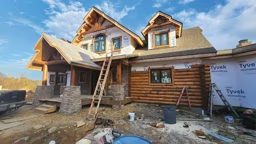We don’t think we’re going out on a limb here when we say that log homes are one of the most easily recognized home styles out there. And yet — even with such long-beloved, easily recognized appeal – there are plentiful ways to alter your log home’s look, thanks to the fact the log home industry is made up of a wide range of companies all around the world, each with its own unique products. Some are small mills that produce only a few homes each year. Others are large operations prepared to make hundreds of homes annually.
About 90 percent of the log homes sold each year are milled — log homes made using saws and machinery that cut and shape raw trees to uniform dimensions that fit together snugly.
The remaining 10 percent of the industry belongs to handcrafted log homes. Handcrafters create their log homes with timbers of differing dimensions that are peeled and cut using hand tools, including drawknives, adzes, chisels and chainsaws or custom techniques. Like any handcrafted item, they require more labor to produce than milled logs and tend to cost a little more.
Some log home producers (handcrafters in particular) erect and build the homes they sell, but many companies mill and fabricate the log package and then hand the components, along with a detailed construction manual and any other building materials they provide, off to an independent builder.
The cost of any log home depends on many factors, not just the logs themselves. In fact, the logs account for only a fraction of the finished cost of a house, and that fraction can vary, depending on factors such as the complexity of the design and labor costs to cut the home. Add in site prep, labor and the price of non-log materials, like the doors, windows, cabinets, floors, etc., and you arrive at the cost to transform the raw building materials into your dream home.
Let’s look at the many ways a log home is created in more depth.
Manufacturers

Log home manufacturers produce their logs using modern, high-speed, precision woodworking machinery. This equipment enables them to cut raw logs into intricate, consistent shapes. The key to the manufactured, or milled, log is the uniformity of the top and bottom horizontal surfaces that fit together. Every log passing through the mill is cut to very close tolerances so that the prepared pieces fit snugly when stacked in a log wall. The visible vertical surfaces are milled to uniform dimensions, although some manufacturers peel these surfaces by hand after milling to produce the more rustic, natural look that many people associate with log homes.
Although some log home manufacturers sell directly to consumers, many sell their homes through representatives, often referred to as builder-dealers or simply dealers. Most dealers work for one company exclusively.
Manufacturers locate their mills in areas with ample access to the wood species they prefer. They often sell the bulk of their homes within a 500-mile radius; however, some companies have expanded operations to reach a broader national market, even venturing abroad.
Handcrafters

Log home handcrafters tend to be smaller operations than their manufactured counterparts. Most produce the logs for their homes in much the same way that early settlers did, often individually selecting and felling the trees they intend to use. Using hand-held tools, they then remove the bark from the trees and cut and shape each log. Some of these tools are power-assisted — chainsaws, chippers, sanders — but others are the same type of equipment used for centuries, such as the broad ax, adze and chisel.
The way handcrafters select and cut their logs differs significantly from the methods used by manufacturers who stress uniformity. Handcrafters generally select logs that span the full length of a wall, and each log is cut and shaped to fit one specific location in the home. When a handcrafter works with full-round logs, each log retains the shape of the tree. Logs are often thicker at the bottom (“butt end”) than at the top. This natural taper requires that handcrafters alternate stacking the logs in their walls — butt to top, then top to butt and so on — so that the wall’s height remains level.
The cut logs are pre-assembled on a temporary foundation in a log yard to check the fit. Then, they’re numbered to record their exact location in the home, disassembled and trucked to the building site for re-erection and finishing.
Each handcrafter is an artisan, and the finished home is often a true work of art. Because the demand today is for increasingly complex handcrafted log homes, more and more of these craftsmen and women are working with engineers and architects for the structural design calculations required to meet building codes.
Whether you opt for a handcrafted log home package or one that’s milled is entirely your choice. Either way, research the companies that make the type of home you prefer and speak to their representatives about your wants and needs. Together, you will arrive at a log home that satisfies.











